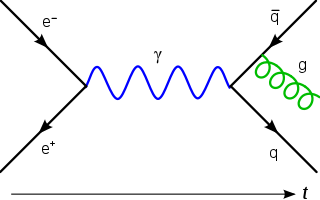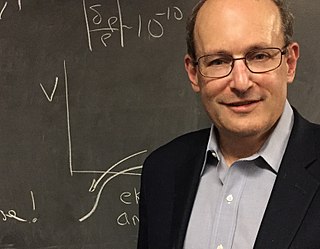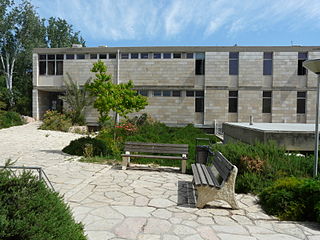Related Research Articles
In physics, the fundamental interactions or fundamental forces are interactions in nature that appear not to be reducible to more basic interactions. There are four fundamental interactions known to exist:

Particle physics or high-energy physics is the study of fundamental particles and forces that constitute matter and radiation. The field also studies combinations of elementary particles up to the scale of protons and neutrons, while the study of combination of protons and neutrons is called nuclear physics.
The following outline is provided as an overview of and topical guide to physics:

In physics, the fine-structure constant, also known as the Sommerfeld constant, commonly denoted by α, is a fundamental physical constant that quantifies the strength of the electromagnetic interaction between elementary charged particles.
Quantum optics is a branch of atomic, molecular, and optical physics and quantum chemistry dealing with how individual quanta of light, known as photons, interact with atoms and molecules. It includes the study of the particle-like properties of photons. Photons have been used to test many of the counter-intuitive predictions of quantum mechanics, such as entanglement and teleportation, and are a useful resource for quantum information processing.

Molecular physics is the study of the physical properties of molecules and molecular dynamics. The field overlaps significantly with physical chemistry, chemical physics, and quantum chemistry. It is often considered as a sub-field of atomic, molecular, and optical physics. Research groups studying molecular physics are typically designated as one of these other fields. Molecular physics addresses phenomena due to both molecular structure and individual atomic processes within molecules. Like atomic physics, it relies on a combination of classical and quantum mechanics to describe interactions between electromagnetic radiation and matter. Experiments in the field often rely heavily on techniques borrowed from atomic physics, such as spectroscopy and scattering.

Paul Joseph Steinhardt is an American theoretical physicist whose principal research is in cosmology and condensed matter physics. He is currently the Albert Einstein Professor in Science at Princeton University, where he is on the faculty of both the Departments of Physics and of Astrophysical Sciences.

The Columbia University Physics Department includes approximately 40 faculty members teaching and conducting research in the areas of astrophysics, high energy nuclear physics, high energy particle physics, atomic-molecular-optical physics, condensed matter physics, and theoretical physics.
In condensed matter physics, an ultracold atom is an atom with a temperature near absolute zero. At such temperatures, an atom's quantum-mechanical properties become important.

Iosif Benzionovich Khriplovich was a Russian theoretical physicist who made profound contributions to quantum field theory, atomic physics, and general relativity.

A nuclear clock or nuclear optical clock is an atomic clock being developed that will use the energy of a nuclear isomeric transition as its reference frequency, instead of the atomic electron transition energy used by conventional atomic clocks. Such a clock is expected to be more accurate than the best current atomic clocks by a factor of about 10, with an achievable accuracy approaching the 10−19 level.

An atomic clock is a clock that measures time by monitoring the resonant frequency of atoms. It is based on atoms having different energy levels. Electron states in an atom are associated with different energy levels, and in transitions between such states they interact with a very specific frequency of electromagnetic radiation. This phenomenon serves as the basis for the International System of Units' (SI) definition of a second:
The second, symbol s, is the SI unit of time. It is defined by taking the fixed numerical value of the caesium frequency, , the unperturbed ground-state hyperfine transition frequency of the caesium-133 atom, to be 9192631770 when expressed in the unit Hz, which is equal to s−1.
The Thomas Ranken Lyle Medal is awarded at most every two years by the Australian Academy of Science to a mathematician or physicist for his or her outstanding research accomplishments. It is named after Thomas Ranken Lyle, an Irish mathematical physicist who became a professor at the University of Melbourne. The award takes the form of a bronze medal bearing the design of the head of Thomas Lyle, as sculpted by Rayner Hoff.

The Racah Institute of Physics is an institute at the Hebrew University of Jerusalem, part of the faculty of Mathematics and Natural Sciences on the Edmund J. Safra Campus in the Givat Ram neighborhood of Jerusalem.

Jun Ye is a Chinese-American physicist at JILA, National Institute of Standards and Technology, and the University of Colorado Boulder, working primarily in the field of atomic, molecular, and optical physics.

National Laboratory of Atomic, Molecular and Optical Physics is the national inter-university research center with the headquarters at Institute of Physics of Nicolaus Copernicus University in Toruń, Poland. Established in 2002, the Laboratory is focused on atomic, molecular, and optical physics (AMO).

Main Magnetic Focus Ion Source (MaMFIS) is a compact ion source with extremely high electron current density. The device is designed for production of ions of arbitrary elements in any charge states, in particular, of highly charged ions of heavy elements.
The I. I. Rabi Prize in Atomic, Molecular, and Optical Physics is given by the American Physical Society to recognize outstanding work by mid-career researchers in the field of atomic, molecular, and optical physics. The award was endowed in 1989 in honor of the physicist I. I. Rabi and has been awarded biannually since 1991.
Marianna S. Safronova is an American scientist involved in theoretical atomic physics.
References
- ↑ "APS Fellows 2008". American Physical Society. Retrieved 31 December 2019.
- ↑ "Andrei Derevianko". University of Nevada, Reno. Retrieved 31 December 2019.